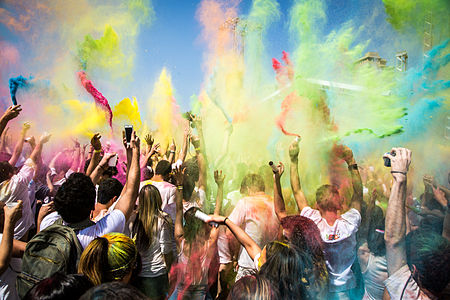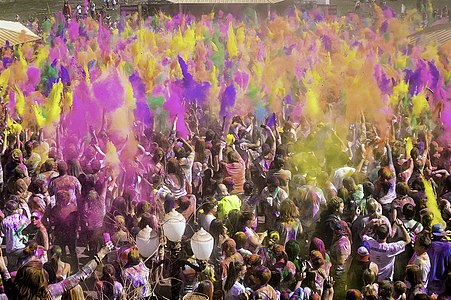Holi Festival of Colors
| Beginning of the tour | July 29, 2012 |
|---|---|
| End of the tour | active for 3 years |
| Total concerts (by continent) |
5 |
| Total concerts (by country) |
60+ |
| Show acts | See: Line-Up |
The Holi Festival of Colors Tour is a series of musical events that takes place in different countries. The concerts are inspired by the Holi spring festival and are based on the colored powder that defines it. It evolved into world-renowned, heavily attended events during the 2010s. The tour was created by “Holi Concept” GmbH, which is operated by the organizers Jasper Hellmann, Max Riedel and Maxim Derenko. The concerts take place on five different continents, between spring and summer, on a Saturday from 12 p.m. to 8 p.m.
history
A festival of this kind took place for the first time on June 29, 2012. This was held in Berlin on the premises of the Postbahnhof . Despite the rainy weather, it was visited by over 2,500 guests. In the same year three more Holi festivals followed: In Munich, Hanover and Dresden. With over 10,000 guests, Munich was considered the largest. In 2013, the Festival of Colors globalized with an opening in Berlin on May 10, 2013. Further Holi festivals were organized on three different continents and seven different countries, including Austria with Vienna, Amsterdam in the Netherlands as well as in Barcelona, Spain and Cape Town, South Africa. The focus of the 2013 tour was again Germany with 15 events in 14 cities. Also in 2013, the festival took place on two consecutive days. The whole thing took place on August 10 and 11, 2013 with over 30,000 participants at Battersea Power Station in London. The largest one-day festival took place in Mannheim with over 20,000 guests. In 2014 the Holi Festival spread across the world. Countries such as Italy (Rome), France (Paris), New Zealand (Auckland), Ireland (Dublin), Tunisia (Hammamet) and Switzerland (Zurich) were added.
procedure
Time schedule
The process is very similar in all cities of the Festival of the Color Tour. The festival starts at 12 noon. Usually the biggest rush does not begin until the afternoon, which is why a small selection of lesser-known warm-up DJs only play shortly after the opening. Each DJ plays a one to two hour set, with the exception of special guests. The first so-called “color countdown” begins at 3 p.m. It counts down from 10, whereupon everyone throws a handful of paint, the so-called gulal powder, into the air. This powder has often been tested in Germany in recent years because accidents with untested powder have occurred abroad. According to the organizer, only tested Holi powder is used in Germany. The countdown is mostly used to end the set of one DJ or DJ team and start that of the next. This process is repeated every hour until the end. In 2015, the Holi Festival in Hamburg set a record by keeping the color cloud alive for a minute. The festival ends at 8 p.m. and the music stops. With the exception of London 2013, the events take place on Saturdays. The reason for the exception was the enormous demand for tickets, which is why two dates, Saturday and Sunday, were organized. An aftermovie is produced for each Holi festival. Furthermore, there are always photo teams on site who publish the pictures taken on the respective Facebook page.

Set up
Generally there is one big stage where the DJs play. In contrast to conventional music events, the stage technology is also equipped with particularly powerful fans. These are supposed to keep the dust clouds away from the stage and prevent the fine dust from getting stuck in all the cracks. Nevertheless, in unfavorable wind conditions, some sensitive devices only have a service life of a few hours and must be overhauled or replaced afterwards. Many of the participants use scarves or dust masks to protect themselves from the risk of pneumonia . There are also show acts such as Indian dancers, drummers and performers as well as an entertainer who provides the mood and the moderation. In addition to numerous food and beverage stands, the sponsors' stands can also be found on the festival site. There is usually a cordoned-off area directly in front of the stage that only a limited number of people may enter. This is secured by security next to a fence. Depending on the choice of cards, the colored powder must be bought together with various goods such as T-shirts, masks, sunglasses or Indian decorations. A festival wristband is only available at the entrance for those over the age of 18;
countries
The Holi Festival takes place in different cities in different countries depending on the year. The focus is particularly on Germany, as the founders of the organization come from Germany. While only a few European countries participated in 2013, the number of countries rose to over 60 by 2015, spread across all continents. Some selected countries and cities can be found in the following table.
music
The music at Holi can mainly be classified into the categories of dance , house and trap . The styles and subgenres vary depending on the DJ and time. The warming-up musicians usually play somewhat shallower, less aggressive music, while towards the late afternoon it becomes more and more danceable and covers the genres of electro and progressive house . Strictly speaking, this also depends on the DJs currently playing. Towards evening the music becomes a bit more deep house- heavy.
Hymns
Several official anthems were published in 2014. The single Save the Night by German DJ and producer Dirty Dasmo was released on April 5, 2014 via Sony Music . The title can be described as a mixture of trance and progressive house. Furthermore, the German record label Kontor Records supports and thus has an influence on both the line-up and the anthems. German Progressive House producer Cuebrick, who was part of the line-up himself, produced two tracks on behalf of the label, on the one hand the song Colorblind and the track Unity , both of which brought him success. The music videos all show excerpts from the festivals.
Line up
The line-up varies from country to country and from city to city. However, there is also a selection of DJs who play at several festivals or not only have a small name in the dance scene, but also celebrated or celebrated great success as producers, including Benga , Kele Okereke , Lexy & K-Paul , Mightyfools, Moguai , Sebastian Ingrosso or the Sick Individuals . Below is a selection of the line-up.
|
|
|
"Holi Festival of Colors" event
Utah 2013"Holi Festival of Colors" event
London, Battersea Power Station 2014“Holi Festival of Colors” event
Spanish Fork , USA 2013
Web links
Individual evidence
- ↑ Article about the first Holi festival
- ↑ Opening 2014 in Berlin
- ↑ Report Holi festivals in Germany are safe
- ↑ Report ( Memento of the original from February 23, 2016 in the Internet Archive ) Info: The archive link was inserted automatically and not yet checked. Please check the original and archive link according to the instructions and then remove this notice. the so-called "Gulal powder"
- ^ Report on Holi in Great Britain
- ↑ Aftermovies on Vimeo
- ↑ Report on the Facebook page Holifestival.de
- ↑ LUXEMBOURG BECOMES COLORFUL. Retrieved on August 22, 2019 (German).
- ↑ Cuebricks Unity on YouTube





